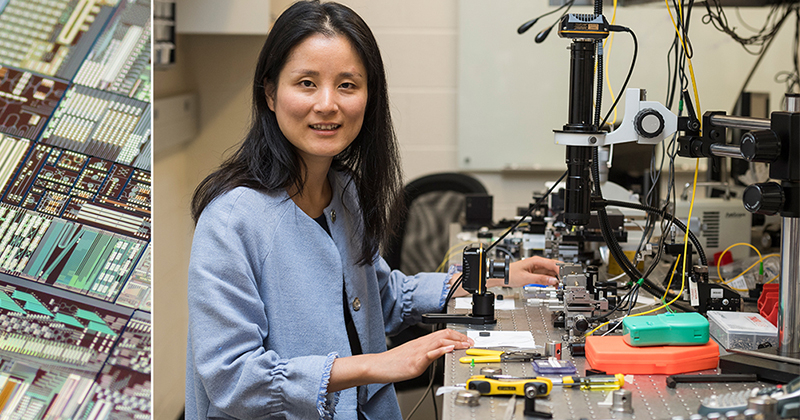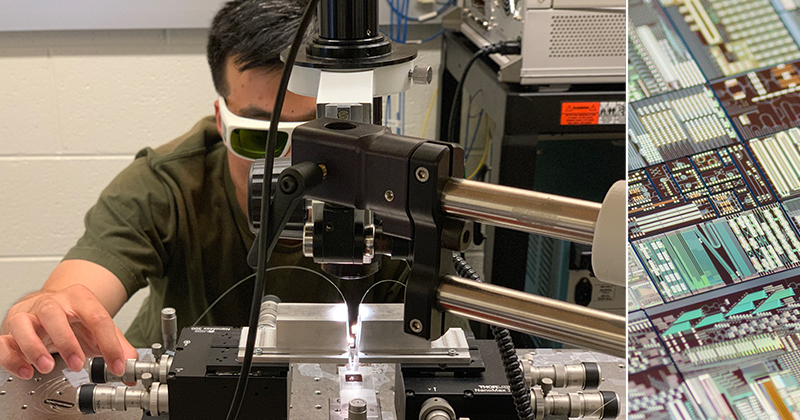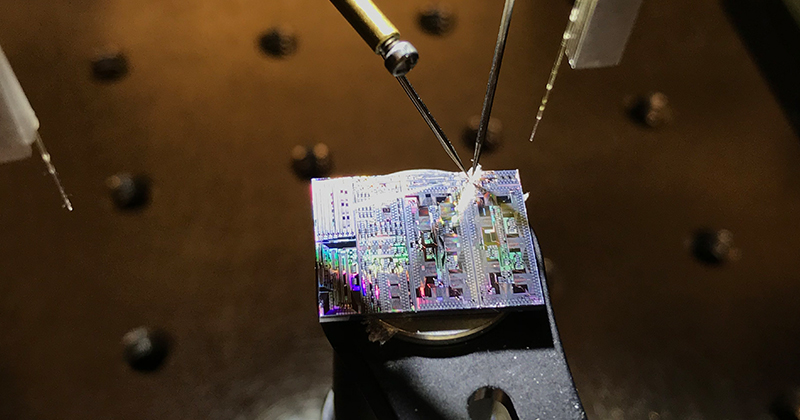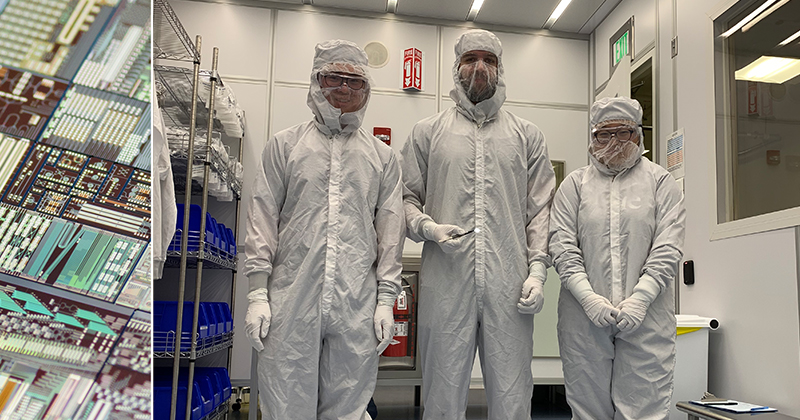


Optical memory of crystals
Photos by Kathy F. Atkinson and courtesy of the Gu lab April 15, 2024
UD’s Tingyi Gu receives NSF CAREER award to study materials that can create more reliable, less energy-intensive forms of computer memory
To develop the types of high-speed, energy-efficient electronic devices that power our daily lives, fundamental research on new materials and devices are essential. One such area of research involves developing new forms of computer memory that don’t require an active power source. Known as non-volatile memory, these types of memory can reduce device energy consumption but are currently limited due to their high cost and low durability.
Tingyi Gu, associate professor in the Department of Electrical and Computer Engineering in the University of Delaware’s College of Engineering, is conducting fundamental research on light-based devices that have a wide range of potential applications. Now, thanks to funding from the National Science Foundation’s Faculty Early Career Development Program (CAREER), Gu will be delving into materials that can create more reliable, less energy intensive forms of non-volatile memory.
Optoelectronic expertise
Before joining UD in 2016, Gu earned a bachelor’s degree in electrical engineering from Shanghai Jiao Tong University and master’s and doctoral degrees, also in electrical engineering, from Columbia University. While initially focused on signal processing, she said she became “intrigued by the complexity and beauty of thermal dynamics” thanks in part to the mentorship of her postdoctoral research advisor at Princeton, Craig Arnold.
When she joined UD, Gu fostered collaborations with Anderson Janotti and Stephanie Law, who is now at Penn State, to extend this research. Now, she has a unique perspective on both hardware and chip design that allows her to work on research problems that cover “both extreme ends of the whole system,” she said.
Through a combination of physics-based simulations and hands-on experiments, both in her laboratory in DuPont Hall and at UD’s Nanofabrication Facility, Gu and her group are leaders in research on state-of-the-art photonic devices — anything that creates, controls or detects light, such as lasers and optical fibers.

One area of her lab’s focus is designing and creating silicon-based chips for photonic integrated circuits. These devices can use light in more complex ways, such as for data analysis or information storage, and have potential applications ranging from advanced optical communication and sensing to machine learning and artificial intelligence.
During her time at UD thus far, Gu has received a number of accolades, including the Air Force Office of Scientific Research Young Investigator Program (2017), the Army Research Office Young Investigator Program (2020), the Young Faculty Award from the Defense Advanced Research Projects Agency (DARPA) and an Early Career Faculty Award from the National Aeronautics and Space Administration. She is also the UD lead supporting Advancing Photonics Technologies, an NSF-funded, multistate collaboration to drive economic and technological advancements in photonics.
Exploration and integration
Now, thanks to this $549,989, five-year award, Gu and her students will be conducting fundamental research on new types of materials for integrated photonic systems that can be used for non-volatile memory. These materials would enable lightweight, low-power applications that can store information at scale without a constant external power source.
While progress in creating optical non-volatile memory has been made in recent years, there are currently limitations in terms of the types of materials available that have the right kinds of properties.
“The major advantage, and one of the pillars of my group, is working on scalable silicon photonic substrates and systems, so we know what is needed on the system side,” Gu said. “But we don't know what material will be the best fit. When searching for these new materials, because there’s no existing catalog, we are looking for something more tailored.”
Gu explained that finding the right material is a particular challenge because while many materials work well in simulations or at nano scales, any bulk level imperfections or property changes can impact their real-world performance.
“We have the right infrastructure to test the device, and from the preliminary work we understand the mechanism,” she said. “Our goal is that, through this CAREER award, we’ll not only provide insights for future researchers but also resources for industries and downstream applications.”
This successful NSF CAREER award proposal was bolstered by a recent study led by Tiantian Li, now an associate professor at Xi'an University of Posts and Telecommunications and a former postdoc in Gu’s lab. In a paper published in Advanced Materials, the group found a new mechanism for creating high-speed optical memory using indium selenide (In2Se3). The discovery of this optical memory response, and the different mechanisms that can be used to control them, paved the way for developing In2Se3 into a type of non-volatile memory that both uses less energy and achieves high performance in terms of speed. Another recent article on Nanophotonics summarized her team’s vision of this new direction for optical memory.

Thanks to this award, Gu and her students will now be able to focus on new material exploration and integration with existing silicon photonic devices.
“We can currently make optical memory devices, but they still require a lot of power and are slow,” Gu said. “Through this project, we want to discover materials that will help us address this bottleneck and make it faster and more energy efficient.”
Building bridges across campus while training the next generation
This CAREER award will also enable Gu to support educational and outreach initiatives here at UD and in the region. These activities will include STEM summer camps with high school interns and undergraduate students as well as plans to foster stronger connections between existing programs that relate to nanofabrication and electronic device design.
“We have many students on campus doing optics and photonics in both engineering and physics programs, and our goal is to see if there is a way to help stitch these programs in different areas together,” she said. “This CAREER award will enable us to interface between students and research labs from theoretical research to hardware and systems engineering.”
“Dr. Gu is a rising star in photonics, as evidenced by an unprecedented recognition through five young investigator awards. Her scholarship in materials and devices is paving the way for integration of photonics for computation and information processing, and is one of the key technology areas identified by the CHIPS and Science Act,” said Jamie Phillips, professor and chair of the Electrical and Computer Engineering department. “I am very excited to see how Tingyi's novel approaches on non-volatile optical memory help to transform optical computing through higher speed and energy efficiency.”
In the next five years, Gu is looking forward to continuing her group’s research on silicon-based photonic chips while also expanding their fundamental understanding of materials that can be used to create new devices in the future. She also added that one of the most important outputs of this award will be the students who will go on to become leaders in this field.
“We want to work towards finding more of these kinds of materials,” she said. “But the primary challenge — the material preparation, fabrication and integration — is the type of in-depth, hands-on work that will empower a student to become a master of device fabrication.”

Contact Us
Have a UDaily story idea?
Contact us at ocm@udel.edu
Members of the press
Contact us at 302-831-NEWS or visit the Media Relations website

